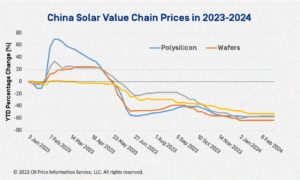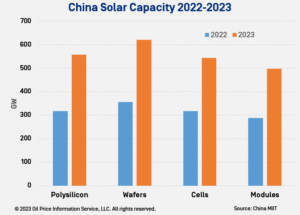Oversupply in China Weighs on Prices across the Solar Value Chain
The prices of the solar supply chain continued to hit new lows in 2023 due to overcapacity in China. The relentless capacity buildup, which the International Energy Agency (IEA) says accounts for 75-95% of the global solar production capacity, is expected to exacerbate the supply glut and drag prices across the solar supply chain down as more capacities are added in 2024.
In 2023, China produced more than 1.43 million metric tons (mt) of polysilicon, an increase of 66.9% from 2022, data from China’s Ministry of Industry and Information Technology showed. Meanwhile, wafer production exceeded 622GW, a year-on-year increase of 67.5%, with wafer exports totaling 70.3GW, an increase of 93.6% from 2022.
Cell production exceeded 545GW in 2023, an increase of 64.9% from the previous year, while exports totaled 39.3GW, a year-on-year increase of 65.5%. Module production exceeded 499GW, up 69.3% from 2022, with exports in 2023 totaling 211.7GW, an increase of 37.8% year-on-year.
 The Global Polysilicon Marker, the OPIS assessment for polysilicon produced outside of China, fell 32.9% over the year to end 2023 at $26.12/kg, the lowest since October 2021. But even this sharp reversal pales in comparison to the 56.07% fall in the China Mono Grade polysilicon price, which ended 2023 at 61.50 yuan per kilogram (kg) ($8.62/kg), the lowest since July 2020.
The Global Polysilicon Marker, the OPIS assessment for polysilicon produced outside of China, fell 32.9% over the year to end 2023 at $26.12/kg, the lowest since October 2021. But even this sharp reversal pales in comparison to the 56.07% fall in the China Mono Grade polysilicon price, which ended 2023 at 61.50 yuan per kilogram (kg) ($8.62/kg), the lowest since July 2020.
Prices of Chinese Mono PERC M10 wafers and cells likewise fell by a massive 60.27% to $0.265 per piece (pc) and 57.54% to $0.0484 per Watt peak (wp) respectively in 2023, while the Chinese Module Marker (CMM), the OPIS assessment for Chinese Mono PERC modules, fell by 47.83% to $0.120/wp, all of which were record lows since OPIS began assessments of these products.
Daqo Energy’s Baotou Phase II 100,000-ton polysilicon plant is expected to start up in the second quarter of 2024, while Hoshine’s Xinjiang 200,000-ton polysilicon plant and Tongwei’s Yunnan Phase II 200,000-ton polysilicon plant are both expected to start up by the end of March.
Around 170,000 mt of polysilicon, or about 70GW of downstream products, were manufactured in China each month in January and February 2024, according to the Silicon Industry of China Nonferrous Metals Industry Association. The amount of polysilicon produced in China might reach 230,000 mt per month by the end of 2024, equivalent to about 95GW of downstream products. A large build-up of polysilicon inventories is anticipated for this year, and that demand pickup will have minimal effect on pricing when there are excessive inventories, states a China-based source.
Furthermore, according to the China Photovoltaic Industry Association, China is expected to add 190-220 GW of solar installations in 2024, indicating a negligible increase compared to the installed capacity of 217GW in 2023.The difficulties associated with power consumption and grid connectivity could lead to a less notable increase in solar installations.
 The wafer segment is likewise seeing similar capacity expansion. Hongxin New Energy’s 20GW ingots and 14GW wafering project in Yunnan and Gaoce’s 25GW wafer plant in Yibin both kicked off production in January 2024.
The wafer segment is likewise seeing similar capacity expansion. Hongxin New Energy’s 20GW ingots and 14GW wafering project in Yunnan and Gaoce’s 25GW wafer plant in Yibin both kicked off production in January 2024.
According to the Silicon Industry of China Nonferrous Metals Industry Association, China produced 63.97 Gigawatts (GW) of wafers in February 2024, which is China’s highest-ever monthly production output of solar wafers. This has led to decreases in the price of N-type wafers due to the necessity of wafer companies to clear the stockpile of N-type wafers that resulted from high production. As of the week of March 5, 2024, N-type wafer prices have been lower than P-type wafer prices, which used to be 10% higher than P-type wafer pricing in 2023. This suggests that N-type wafer market has engaged in a pricing war.
Furthermore, there are continuous expansions in the production of cell and module segment as well:
- Qingdian Changxin’s 13.2 GW of TOPCon cell facility in Hefei officially started production on Jan. 28, 2024
- Renesola plans to begin construction on its 5GW cell project in Jiangsu in March and to begin production in July 2024.
- Qnsolar’s Phase I 5 GW cell and 3GW module plant in Hubei is expected to start up in the first quarter of 2024
- DAS Solar’s 2.4GW module plant started production in January
- LONGi’s 10GW module plant in Zhejiang is expected to reach full production in May
The headlong rush to build new solar facilities took hold during the market’s two-year bull run in 2020-2022, but the industry is now struggling to stay afloat in the supply deluge. Operating rate cuts and bouts of sell-offs were already common across the solar supply chain during the fourth quarter of 2023, with prices in all segments falling to a hair’s breadth above or even below cash costs.
Market players expect this to continue in 2024. A further decline in polysilicon prices to 50 yuan/kg is possible given the fall in production costs of the raw material. This is especially as older polysilicon factories with higher manufacturing costs are being decommissioned, which would lower polysilicon’s average production cost to below 60 yuan/kg.
If the Chinese solar supply chain continues to operate at razor-thin or negligible margins in this scenario, wafer costs could fall further to 1.862 yuan/pc, cells to 0.386 yuan/wp, and modules to 0.836 yuan/wp. On paper, from a production cost standpoint, module prices could fall no further below this.
But this is only in theory. According to company sources, module makers that are not established tier-1 solar majors are already selling below costs, several of whom had joined the 2020-2022 solar gold rush from unrelated industries. Market consolidation is a likely consequence, which sees unprofitable companies exiting the industry in a “survival of the fittest” scenario.
The next phase in the solar industry, which is currently running at a loss overall, is to remove obsolete production capacity. This could take a very long time since occasional demand spikes would push prices higher, allowing ailing companies more room to turn a profit and survive longer. However, any price hike before the industry consolidation might only be temporary, according to a source.
It’s critical for solar manufacturers to lower production costs and boost product efficiency in the race to survive. It’s important to set up research & development departments to work toward minimizing consumables. Moreover, solar producers may find it helpful to increase the capacity for producing auxiliary materials, said a source.
